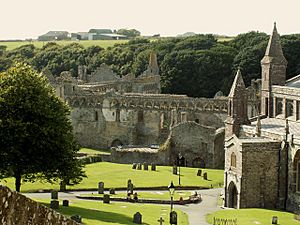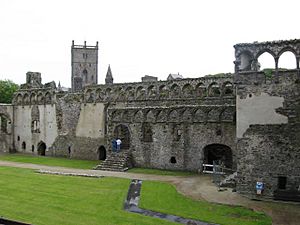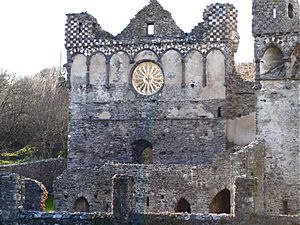St Davids Bishops Palace facts for kids

The St Davids Bishops Palace (also known as Bishop's Palace) is a cool old ruin next to St Davids Cathedral in St Davids, Pembrokeshire, Wales. This area has been super important for religion in Wales for a long time. While the site has been around since the 500s, the palace you see today was mostly built in the late 1200s and 1300s.
Today, the palace is looked after by Cadw, which is the Welsh Government's group for historic places. It's a popular spot for visitors and even hosts outdoor plays. Because it's right next to the famous cathedral, over 300,000 people visit every year. It's also a Grade I listed site, meaning it's a very important historical building.
Contents
A Look Back: Early History of the Palace Site
St Davids was once home to the Marcher Lords. These were powerful lords who guarded the border between England and Wales. This made the area a very important place for defense. It was also a huge religious spot because it held special items belonging to St David, who is the patron saint of Wales. Even William the Conqueror visited as a pilgrim in 1081!
The first monastery (a place where monks lived) was built here in the 500s. But over the next 400 years, Viking raiders attacked it at least 10 times. Things became more stable when the Normans arrived in the 1000s. They put a Norman bishop in charge. To protect the site, they built a motte and bailey fort (a simple castle on a mound) and later a strong stone wall.
Who Built the Palace?
The Bishops Palace was built by several "builder bishops" over time. Most of the work happened in the late 1200s and 1300s.
Bishop Thomas Bek's Contributions
In 1284, King Edward I visited St Davids. This visit might have encouraged some early building work. Bishop Thomas Bek, who was bishop from 1280 to 1293, had worked for the King before. Bishop Bek was responsible for building the chapel, the main hall, the private rooms, and the gate.
Bishop Henry de Gower's Grand Design
The person who built most of the palace you see today was Bishop Henry de Gower (1328–1347). He also did a lot of work on the cathedral itself. He built the amazing Great Hall with its special wheel window (a round window that looks like a wheel) in the east wall. He also added the unique arched walls and the porch. Gower's biggest projects were the two large sections of the palace. The east section was simpler and built first. The much grander south section was designed for hosting important guests.
Why the Palace Fell Apart
The start of the Reformation (a big change in the church) in the 1500s also marked the decline of the Bishops Palace. In 1536, Bishop William Barlow took the lead off the roof. People say he used the money to pay for his daughters' weddings. However, this story was probably made up by his enemies, as he didn't have daughters at that time. He made so much money that it would have cost more than 12 years of the bishop's income to fix the roof! Because of this, the building fell into ruin. Bishops started staying less at St Davids. By the mid-1500s, the main home for the bishop had moved to Abergwili. By 1678, the palace was considered too broken to fix.
Why This Place is So Important
Professor Ralph A. Griffiths, a history expert, has called St Davids Cathedral and Bishops Palace "one of the most significant sites in the history of Christianity in the British Isles." He also said it's where "Welsh Christianity and nationalism are entwined," meaning it's a place where Welsh history and faith are strongly connected.
Much of the old town wall is still standing, especially on the south side. The main gate into the cathedral area, called Porth-y-Tŵr, was built around 1300 and is still complete. Inside the palace ruins, most of the structure remains, even though it's open to the weather.
Taking Care of the Palace: Conservation Work
By the 1990s, the Bishops Palace was in serious trouble. The building materials, a mix of local stone and volcanic rock, were wearing away because of the weather. Important parts like decorated stonework, windows, and sculptures were eroding. Some walls were getting so thin they might collapse.
Under the guidance of Cadw, a big repair project started in 2003 and finished in 2009. Workers rebuilt some walls and fixed damaged carvings. They also made it easier for visitors to get around by replacing floors on the ground level. This project was even nominated for a special award called the Grand Prix Europa Nostra, which celebrates cultural heritage.
The Palace in Art
The Bishops Palace has inspired artists, including the famous British painter Turner. He drew the palace in his South Wales Sketchbook in 1795. These drawings are now part of the Turner Bequest at the Tate gallery. One drawing shows the inside of the ruins, and another shows the entrance to the Great Hall.
Images for kids




